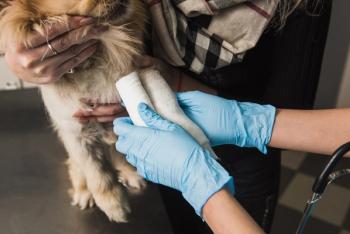
Radiologist: Imaging of awake patients is a matter of ethics
Emergencies, heart failure cases, airway disease patients can all benefit from CT without anesthesia, expert says.
One of the most exciting new forms of respiratory imaging is the use of multiple-slice computed tomography (CT), says Robert O'Brien, DVM, MS, DACVR, professor at the University of Illinois College of Veterinary Medicine, who spoke at CVC Washington, D.C., this year. Multislice CT provides extremely rapid imaging, which opens the door to imaging awake veterinary patients on an emergency basis.
What's more, O'Brien says, the veterinary profession is ethically obligated to make use of advancing technology for the well-being of patients.
“I am very controversial in the American College of Veterinary Radiology,” O'Brien told his CVC audience. “My peers do things the same way-everybody gets anesthetized, everybody gets the same dose of contrast, everybody gets treated the same way they've always been treated. I have real ethical problems with that. There's a better way to do it.”
O'Brien's better way is to forego anesthesia whenever possible. “In 80 percent of my cases we use no general anesthesia,” he says. This is particularly valuable in cases where anesthesia is medically contraindicated, such as feline congestive heart failure, in functional airway diseases that are obscured by the presence of an endotracheal tube or positive air pressure, or in emergency patients where time is of the essence in reaching a diagnosis and commencing treatment.
“You lower morbidity by getting rid of anesthesia. You lower the financial burden. You get better imaging because the lungs are moving and breathing normally,” O'Brien says. “I'm more than happy to put up with a little motion to get things to look like what they really look like while the animal is out in the world.”
In order to obtain these CT images quickly and safely, clinicians need to limit the patient's motion and maintain an oxygen-rich environment, O'Brien says. “There should be no sacrifice in morbidity to the patient,” he says.
Dr. Robert O'Brien of the University of Illinois, shown here with his cat Michael, developed a motion-limiting device called the VetMouseTrap that maintains an oxygen-rich environment and enables speedy acquisition of CT scans. (Photo courtesy of the University of Illinois.)
To that end, O'Brien has developed a device called the
The VetMouseTrap can also be used without a lid (left) and modified for birds. (Photos courtesy of Dr. Robert O'Brien.)
O'Brien says that CT is becoming more common in general practice. When he provides teleradiology services to veterinarians, most of the images he sees are coming from general practices. “CT is coming soon to a neighborhood near you, if it's not already there. So it's good to be aware of what CT can do,” he says. “With awake CT, the world is wide open to be imaged.”
Newsletter
From exam room tips to practice management insights, get trusted veterinary news delivered straight to your inbox—subscribe to dvm360.





